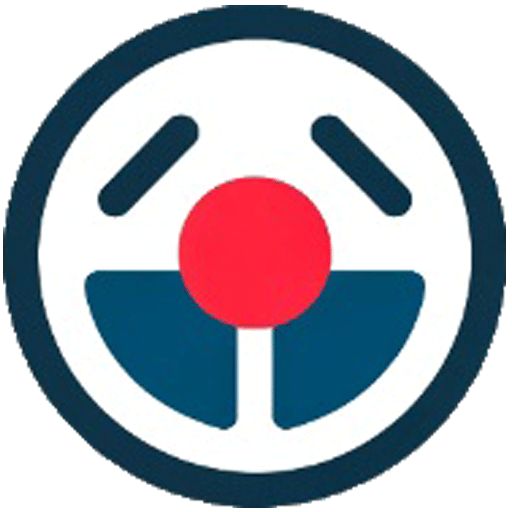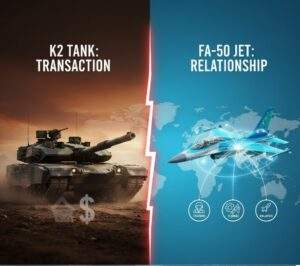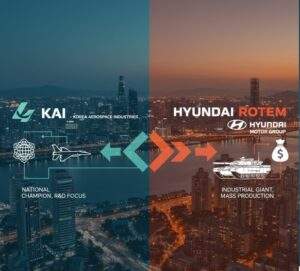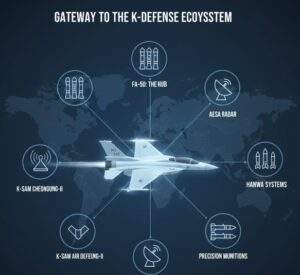KAI’s FA-50, K-Defense’s True Strategic Play
When international media covers South Korea’s explosive rise as a global defense exporter, the headlines are inevitably dominated by one platform: the K2 Black Panther main battle tank. The nine-figure deals and images of heavy armor rolling onto Polish soil are visually impressive and represent a massive commercial win.
But from a perspective in Seoul, this focus on heavy armor, while warranted, misses the real story.
The true centerpiece of K-Defense’s long-term global strategy isn’t the 60-ton tank; it’s the 13-ton light combat aircraft. What analysts in Korea understand is that while Hyundai Rotem’s K2 tank generates revenue, Korea Aerospace Industries’ (KAI) FA-50 Fighting Eagle generates strategic integration.
And for the future of K-Defense, the latter is infinitely more valuable.
The K2 “Headline Grabber” vs. The KAI’s FA-50 “Relationship Builder”
The K2 tank is a phenomenal “door opener.” Its multi-billion dollar deal with Poland single-handedly put K-Defense on the map as a premier global supplier, proving it could deliver top-tier capability faster and more reliably than many Western competitors. It is, without question, a high-value transaction.
The FA-50, however, is a high-value platform. This distinction is fundamental.
When a nation buys a tank, it buys a product. When a nation buys a squadron of advanced jets, it buys into a 30-year industrial, training, and technological relationship. The K2 is a sale; the FA-50 is a strategic partnership.
The “Long Tail” Revenue Stream US Media is Missing
For the investor and analyst audience, the business model difference is stark. A tank is largely a one-off capital expenditure, followed by a moderate, predictable service life and maintenance plan.
An advanced jet’s lifecycle value (LCV) dwarfs its initial sticker price. The real money isn’t in the airframe; it’s in the ecosystem required to keep it flying.
This “long-tail” revenue stream, which analysts in Korea view as KAI’s core business model, includes:
- Pilot & Ground Crew Training: This is not a one-time event. It is a continuous pipeline, establishing Korean doctrine and systems as the foundation for a partner nation’s air force.
- MRO and Spare Parts: Maintenance, Repair, and Overhaul (MRO) contracts are a lucrative, multi-decade annuity. An FA-50 flying in Poland, Malaysia, or Egypt is a customer for life, tethered to KAI’s supply chain.
- Future Upgrades: The FA-50 platform is designed to evolve. Mid-life upgrades—integrating new AESA radars from Hanwha Systems, advanced electronic warfare pods, or new munitions—are not just possibilities; they are a built-in business plan.
- Munitions Sales: Every jet needs weapons. The FA-50 acts as a delivery vehicle for a vast portfolio of Korean-made precision munitions from partners like LIG Nex1 and Hanwha.
The Seoul Insider’s Angle: KAI vs. Hyundai Rotem
To understand why the FA-50 is so central to national strategy, one must understand the distinct corporate and political dynamics at play here in Seoul—a cultural nuance often lost on Western media.
Hyundai Rotem, the K2’s maker, is a highly successful division of the Hyundai Motor Group, one of the world’s largest chaebols (family-owned industrial conglomerates). Its success is seen as a massive industrial and commercial victory.
Korea Aerospace Industries (KAI) is different.
KAI is Korea’s sole national aerospace champion. It is a state-backed entity, with the Korea Development Bank (KDB) as a major shareholder, and it carries the political mandate for national technological sovereignty. KAI is not just a company; it is the incubator for Korea’s most ambitious defense projects, including the 4.5-generation KF-21 Boramae fighter.
Local Korean reporting treats KAI’s exports as a validation of national R&D and technological prestige. The FA-50 is the commercial export that funds the R&D for the KF-21, and the KF-21, in turn, provides the next-generation technology to upgrade the FA-50. They are two halves of a single national strategy.
This deep state-level backing and R&D-centric identity mean the FA-50’s export success is viewed in Seoul as a core strategic imperative, far beyond the commercial calculus of a tank sale.
The FA-50 as a “Gateway” to the Full K-Defense Ecosystem
Herein lies the most critical point: the FA-50 is the “gateway” for the entire K-Defense portfolio.
A nation that buys the FA-50 is not just buying a jet. They are now a prime, integrated customer for a host of interconnected systems. The sales logic becomes seamless:
- Air-to-Air/Ground Munitions: Now that you fly our jet, you need our (LIG Nex1) KGGB smart bombs and air-to-air missiles, all perfectly integrated off the shelf.
- Avionics & Radar: Ready for an upgrade? Our (Hanwha Systems) AESA radar is the next logical step.
- Air Defense: You now need a ground-based air defense system that can instantly identify your new jets as “friendly.” Our K-SAM (Cheongung-II) system, which just won deals in the UAE and Saudi Arabia, is designed to do just that.
The FA-50 is the hub, and the rest of Korea’s defense industry—from LIG Nex1 to Hanwha—provides the spokes. It locks a partner nation into a Korean-made ecosystem, making future procurement decisions heavily favor “Made in Korea” for the sake of interoperability.
The Verdict: Why the FA-50 is the True Core
The K2 Black Panther is an exceptional product that has rightfully earned its headlines. It generates massive, immediate revenue and has proven K-Defense can compete with anyone.
But from a strategic, long-term perspective, the FA-50 is the true core of Korea’s global ambitions.
The K2 builds a customer base. The FA-50 builds technological and strategic dependencies. For high-value investors, policymakers, and defense analysts, understanding this distinction is the key to understanding the real K-Defense strategy. One platform secures a contract; the other secures a 30-year partnership.
Hi, I’m [jeybee]. As a long-time resident of Seoul, I’m passionate about uncovering the authentic, everyday magic of Korea. This blog is my way of sharing my favorite spots, tips, and cultural insights with you, beyond the usual tourist traps.




